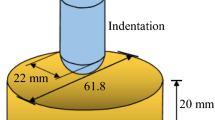Abstract
According to an exhibition of clay soils consisting of not only elastic but also viscous properties, we present Kelvin-Voigt model combined by an elastic spring and a damper in parallel to investigate the dynamics of crack opening. The equation of motion of crack opening is derived mathematically from the equilibrium equation; that means the frictional shear stress is equal to the tension in the soil. After obtaining the equation of motion, the experiments were carried out in laboratory on Kaolin to validate the proposed model through cracks. The obtained experimental data were fitted by the dynamical equation of motion using curve-fitting method. The results indicate that the proposed model yields a good correlation between the experiment data and the computed values with the fairly high coefficient of regression (=0.98). Therefore, it is concluded that the proposed Kelvin-Voigt model can be used appropriately for describing the dynamics of crack opening in clays.
Similar content being viewed by others
References
Albrecht, B.A. and Benson, C.H. (2001). “Effect of desiccation on compacted natural clays.” Journal of Geotechnical and Geoenvironmental Engineering, Vol. 127, No. 1, pp. 67–75.
Chertkov, V.Y. and Ravina, I. (1999). “Morphology of horizontal cracks in swelling soils.” Theoretical and Applied Fracture Mechanics, Vol. 31,Issue 1, pp. 19–29.
Haddad, Y.M. (1995). Viscoelasticity of Engineering Materials, University of Ottawa, Ottawa, Canada.
Horgan, G.W. and Young, I.M. (2000). “An empirical stochastic model for the geometry of two-dimensional crack growth in soil.” Geoderma, Vol. 96,Issue 4, pp. 263–276.
Hu, L.B., Peron, H., Hueckel, T., and Laloui, L. (2006). “Numerical and phenomenological study of desiccation of soil.” Advances in Unsaturated Soil, Seepage, and Environmental Geotechnics (GSP 148), Proceedings of Sessions of GeoShanghai 2006, pp. 166–173.
Karalis, T.K. (2003). “Integrated effects on the shrinkage stresses from the water loss in soft cohesive soils.” International Journal of Engineering Science, Vol. 41,Issues 3–5, pp. 371–385.
Katainen, J., Paajanen, M., Ahtola, E., Pore, V., and Lahtinen, J. (2006). “A dhesion as an interplay between particle size and surface roughness.” Journal of Colloid and Interface Science, Vol. 304,Issue 2, pp. 524–529.
Kodikara, J.K., Barbour, S.L., and Fredlund, D.G. (2000). “Desiccation cracking of soil layers.” Unsaturated Soils for Asia, Rahardjo, Toll & Leong (eds). Balkema, Rotterdam, ISBN 90 5809 139 2, pp. 693–698.
Konrad, J.-M. and Ayad, R. (1997). “Desiccation of a sensitive clay: Field experimental observations.” Canadian Geotechnical Journal, Vol. 34, No. 6, pp. 929–942.
Lecocq, N. and Vandewalle, N. (2003). “Dynamics of crack opening in a one-dimensional desiccation experiment.” Physica A: Statistical Mechanics and Its Applications, Vol. 321,Issues 3–4, pp. 431–441.
Mal, D., Sinha, S., Mitra, S., and Tarafdar, S. (2005). “Formation of crack networks in drying laponite films.” Physica A: Statistical Mechanics and Its Applications, Vol. 346,Issues 1–2, pp. 110–115.
Mastrangelo, C.H. and Hsu, C.H. (1993). “Mechanical stability and adhesion of microstructures under capillary forces — Part I Basic theory.” Journal of Microelectromechanical Systems, Vol. 2, No. 1, pp. 33–43.
Mastrangelo, C.H. and Hsu, C.H. (1993). “Mechanical stability and adhesion of microstructures under capillary forces — Part II Experiments.” Journal of Microelectromechanical Systems, Vol. 2, No. 1, pp. 44–55.
Morris, P.H., Graham, J., and Williams, D.J. (1993). “Cracking in drying soils.” International Journal of Rock Mechanics and Mining Science & Geomechanics Abstracts, Vol. 30, No. 2, pp. 263–277.
Peng, X., Horn, R., Peth, S., and Smucker, A. (2006). “Quantification of soil shrinkage in 2D by digital image processing of soil surface.” Soil & Tillage Research, Vol. 91,Issues 1–2, pp. 173–180.
Persson, B.N.J. and Tosatti, E. (2001). “The effect of surface roughness on the adhesion of elastic solids.” Journal of Chemical Physics, Vol. 115, No. 12, pp. 5597–5610.
Quintanilla, M.A.S., Valverde, J.M., and Castellanos, A. (2006). “Adhesion force between fine particles with controlled surface properties.” AIChE Journal, Vol. 52, No. 5, pp. 1715–1728.
Ratwani, M.M., Kieboom, O.T., and Heslehurst, R.B. (2006). “Crack opening displacement in plate with bonded repair patch.” Fracture of Engineering Materials, Vol. 29, No. 38, pp. 425–430.
Thouless, M.D. (1994). “Fracture mechanics for thin-film adhesion.” IBM Journal of Research and Development, Vol. 38, No. 4, pp. 367–377.
Velde, B. (1999). “Structure of surface cracks in soil and muds.” Geoderma, Vol. 93,Issues 1–2, pp. 101–124.
Velde, B. (2001). “Surface cracking and aggregate formation observed in a Rendzina soil, La Touche (Vienne) France.” Geoderma, Vol. 99,Issues 3–4, pp. 261–276.
Vogel, H.-J., Hoffmann, H., and Roth, K. (2005a). “Studies of crack dynamics in clay soil I. Experimental methods, results, and morphological quantification.” Geoderma, Vol. 125,Issues 3–4, pp. 203–211.
Vogel, H.-J., Hoffmann, H., Leopold, A., and Roth, K. (2005b). “Studies of crack dynamics in clay soil. II. A physically based model for crack information.” Geoderma, Vol. 125,Issues 3–4, pp. 213–223.
Waller, P.M. and Wallender, W.W. (1993). “Changes in cracking, water content, and bulk density of salinized swelling clay field soils.” Soil Science, Vol. 156, No. 6, pp. 414–423.
Weinberger, R. (1999). “Initiation and growth of cracks during desiccation of stratified muddy sediments.” Journal of Structural Geology, Vol. 21,Issue 4, pp. 379–386.
Wijeyesekera, D.C. and Papadopoulou, M.C. (2001). “Cracking in clays with an image analysis perspective.” Clay Science for Engineering, Adachi & Fukue (eds) Balkema, Rotterdam, ISBN 90 5809 175 9, pp. 437–482.
Yesiller, N., Miller, C.J., Inci, G., and Yaldo, K. (2000). “Desiccation and cracking behavior of three compacted landfill liner soils.” Engineering Geology, Vol. 57,Issues 1–2, pp. 105–121.
Author information
Authors and Affiliations
Corresponding author
Rights and permissions
About this article
Cite this article
Min, TK., Vo-Dai, N. Kelvin-Voigt model for dynamics of crack opening in shrinkage cracking. KSCE J Civ Eng 12, 149–154 (2008). https://doi.org/10.1007/s12205-008-0149-2
Received:
Accepted:
Published:
Issue Date:
DOI: https://doi.org/10.1007/s12205-008-0149-2




